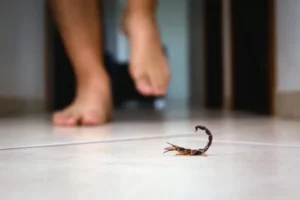Home / Blog / Getting Rid of a Pantry Beetle Infestation
Getting Rid of a Pantry Beetle Infestation

Scientifically reviewed by Daniel Baldwin, BCE, CCFS, CP-FS
-Published on May 19, 2023
-Updated on May 19, 2023
Pantry beetles are household pests that invade dry food storage areas like pantries, cabinets, and counters. They are drawn to stored products, particularly food grains, and can quickly overtake an unwatched pantry or shelf. If you’re dealing with a pantry beetle infestation in your home, use this guide to learn about them and how to remove them from your home safely and effectively.
What are pantry beetles?
Pantry beetles are commonly referred to as grain beetles or flour beetles. There is a variety of stored product pests, including the confused flour beetle, sawtooth beetle, and merchant grain beetle. These beetles feed on many food products commonly found in homes, including dried legumes, pasta, spices, chips, crackers, cereals, grains, and pet foods. Pantry beetles look like small, common beetles and can sometimes be mistaken for small cockroaches or bed bugs. They’re typically a brown or reddish brown hue and about ⅛ to ¼ inches long. Their general shape appears long and thin with slightly rounded features. You may see pantry beetles crawling on shelves, in cupboards, or inside stored food.

Are pantry beetles harmful?
Pantry beetles are relatively non-threatening, as they can’t scratch or sting. Pantry beetles don’t bite and are far more likely to scurry away from you than attempt any interaction. The problem they pose comes from an infestation contaminating dry packaged foods. They usually lay their eggs in dry goods and can spread pathogens if the infested food gets eaten.
Do pantry beetles fly?
Most varieties of pantry beetles do not have wings and can’t fly. They typically travel by crawling and usually like to remain hidden from humans and domesticated animals. However, some stored product pests can fly, including red flour beetles, drugstore beetles, cigarette beetles, and pantry moths.
What attracts pantry beetles?
As with most pests, pantry beetles are attracted to easy food sources, water, and shelter. Pantry beetles eat grains, processed foods, dried fruits, beans, nuts, and spices. However, they aren’t a picky species and will turn to any dried food stored at room temperature to survive. The chance of a pantry beetle infestation increases when you keep dry goods in containers without tight seals or in areas with heavy food debris or crumbs.
How do you get rid of pantry beetles?
Removing their access to food and shelter is one of the best ways to help get rid of pantry beetles. First, find and remove any infested pantry items. Seal and bag any infested products and throw them away outside. Clean your entire pantry thoroughly, taking special care to remove any dried food spills on shelves. Store your dry goods in air-tight containers to prevent pantry beetles from gaining access in the future. Make sure to clean up any crumbs or spills right away to keep your pantry area tidy and unappealing to pantry beetles.
How to get rid of pantry beetle larvae
Pantry beetle larvae are small and pale, making them extremely difficult to notice in most common household grains. To remove pantry beetle larvae, throw out any contaminated products. Vacuum out your pantry shelves and floors, paying particular attention to corners. Use soap and water to clean any residue.
How to clean a container with pantry beetles
To clean a container with a pantry beetle infestation, empty the canister and wash it with soap and warm water. Take the contents to your outside trash right away. Wipe down the container with a food-safe sanitizer and allow it to air dry completely.
Pest control services
The best way to address pantry beetles in your home is to hire a pest control company like Hawx Pest Control. We offer safe and affordable treatment for your current problems and preventative remedies to address potential threats before they happen. Our teams focus on ensuring the highest quality result, leading to a safer and more reliable outcome. Call us today for a free estimate to get your pest problem under control and restore peace to your home.
Related Articles
Visit our blog to learn more.
→





